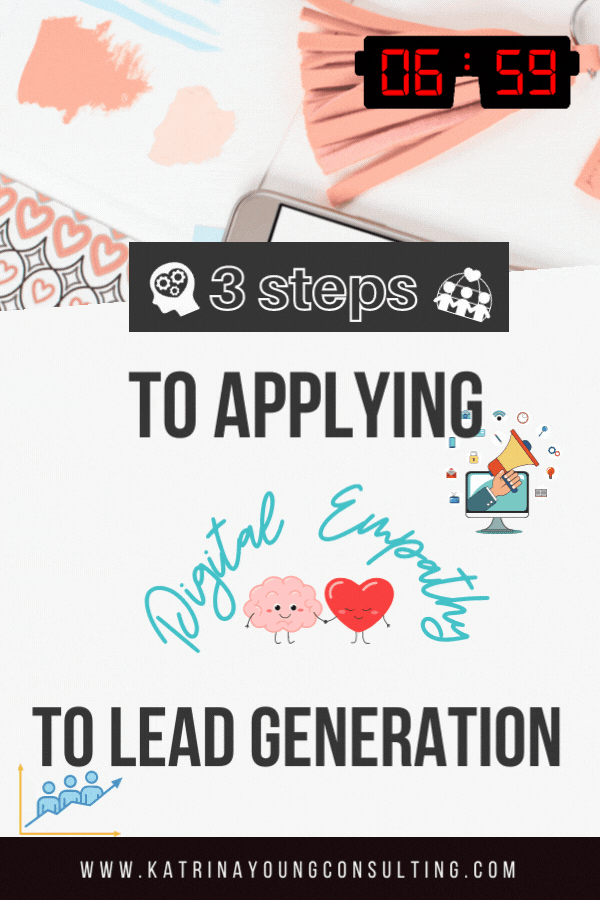The essential 3 steps to applying Digital Empathy to Lead Generation
What is Digital Empathy and why is it important to lead generation?
Generating more leads is important for getting new customers, however, it can be costly and difficult. Digital empathy is a proven way to uncover buyer intent and do that.
The three steps of digital empathy are:
1) Uncover the underlying problem
2) Offer a solution
3) Deliver a compelling proposition
This blog will make it easier to understand how digital empathy works and show you the steps to get started, ideate, audit, and implement.
Digital Empathy is all about understanding your customer's needs and how to provide them with the best experience. This is an important distinction as it goes beyond simply providing a good user experience. How many times have you heard a sales representative say that they sold you something because their competitor could not help you? That situation directly results from their lack of empathy towards their customers. The sales representative relied on your need to be served quickly, or rather, they did not serve you enough time to consider your options, which resulted in the sale being lost. You may also hear this referred to as "compassion fatigue" because the seller sees only what they want from their customers, instead of seeing it from the customer's perspective.
Digital Empathy is the application of empathy to the digital world. It’s about understanding your customer and providing the best experience.
Lead generation relies on Digital Empathy because it helps you learn what content will work best for your target audience and create an effective strategy that can be measured, optimised and scaled.
By focusing on and empathising with your customers, you are able to better understand their needs and challenges, which leads to a more personalised approach. According to research from Accenture Strategy, 44% of consumers claim that they would change providers if they didn’t feel their current provider understood them or their needs.
One of the keys to lead generation is making sure your customers feel like you understand them at every point in the buyer journey—and this includes when someone first becomes aware of your brand, as well as when they decide whether or not to do business with you.
The essential 3 steps to applying Digital Empathy to Lead Generation
〰️
The essential 3 steps to applying Digital Empathy to Lead Generation 〰️
Empathy plays an important role in helping your business succeed. By connecting with your customers and putting yourself in their shoes, you can provide more valuable services and more personalised conversations to build trust and drive demand.
How can you apply Digital Empathy to your lead generation strategy?
understand who your customers are
understand the customer journey
understand the value of your product or service
use all the information you have gathered to create a better customer experience
The most successful businesses understand that Digital Empathy is a never-ending process. Any customer would be quick to point out the distinct difference between a business that simply listens, and one that actively works to adapt its offering for each customer’s needs.
This is why the 3 steps above must become an integral part of how you approach your company’s lead generation strategy if you want to see results. If you want customers to choose your product or service over those of your competitors, it’s crucial that you understand where they are coming from in order to create a seamless user experience and engage them in every step of their journey.
The most successful businesses understand that Digital Empathy is a never-ending process. Any customer would be quick to point out the distinct difference between a business that simply listens, and one that actively works to adapt its offering for each customer’s needs.
This is why the 3 steps above must become an integral part of how you approach your company’s lead generation strategy if you want to see results. If you want customers to choose your product or service over those of your competitors, it’s crucial that you understand where they are coming from in order to create a seamless user experience and engage them in every step of their journey.
Going beyond transactional relationships with customers will help your business grow and become more sustainable.
Importance of having a connection with customers
Customer Journey and Emotional Journey
Digital Empathy is knowing your customers and feeling their pain
Digital Empathy helps you to understand your customers' needs
Going beyond transactional relationships with customers will help your business grow and become more sustainable.
Digital Empathy is a great way to accomplish this. It helps you know your customers better, and as a result, understand their needs better. The seven principles of Digital Empathy describe the importance of empathy for solving customer problems and for generating leads and sales. Let’s check out some of these principles:
Put the customer first in everything you do: To solve customer problems, you must put them first and think about their needs. But that usually means going above and beyond what they ask for to truly delight them. In order to generate leads and sales, you need to place yourself in the shoes of the customer and understand what steps they will take from Awareness to Decision. This user experience journey is called the Customer Journey, but it should also reflect an Emotional Journey where there are ups and downs before reaching a decision or sale. Digital Empathy lets us create content that helps our audience progress through these stages by understanding their pain points at every stage (Awareness Stage, Consideration Stage, Decision Stage). When your content resonates with people because it speaks directly to them on an emotional level (to achieve the goals we have to overcome obstacles), then they are more likely to trust you at every stage which means they are more likely to become a happy customer who trusts you enough to recommend your product or service (loyalty) - which means even more new leads who can not only bring recurring revenue but also new revenue opportunities with referral marketing efforts (sustainability).
2nd person (you/your/yours) example: Businesses need digital empathy so that they can focus on building long term relationships instead of short term transactions. By asking yourself “What would I do if I were in my customer's shoes?” or “If I had my customer's wants/needs/goals/pain points
The importance of this can’t be understated. No longer do businesses have the ability to simply ‘push’ content at their audiences in the hope that they take your desired action. The customer journey has become more complex and the emotional journey is increasingly important.
If you’re not understanding your customers, your competitors will be. If you don’t know their pain points and desires, then how can you expect them to trust you? Ultimately, it leads to better lead generation, as more companies are finding out.
It's time to move away from the transactional mindset of lead generation and towards developing long-lasting relationships with your customers. It's important to ask what they want and feel their pain. It's also important to understand their needs by using segmentation, customer journey mapping, and data analysis tools.
You don't need expensive tools to start incorporating digital empathy into your lead generation strategy. As a matter of fact, it can be started right now by simply asking yourself if you're treating leads as actual human beings instead of just mere statistics that are going to give you numbers.
Digital marketing is all about making personal connections with customers, and transparency is a critical aspect of that. It’s important to remember that not every customer will be in the market for your product or service at the exact moment you reach out to them. However, that doesn’t mean that they won’t turn into valuable leads in the near future.
Customers who have a positive experience with your brand are often more likely to become repeat customers; conversely, those who buy from you once and feel ignored or taken for granted may never return again. These one-time transactions can hurt your bottom line and brand reputation, so it’s vital to establish trust and empathy in every interaction between your business and its customers.
Practising digital empathy doesn't just show customers that you care about them—it also helps you understand their needs better, which can lead directly to more qualified leads down the road. If a customer's purchase journey is important because they've already made contact with you before buying anything else on their list, then it can make sense for marketers
To connect these journeys together by focusing on building deeper relationships through an empathetic approach rather than just trying hard to sell.
Create a framework for building Digital Empathy that can be applied to every step of your lead generation process. While emotion plays a significant role in human decision-making, empathy is about considering and understanding others’ emotions as well – something that poses a challenge for digital experience when purchasing.
Digital empathy can help you attract and convert more of the right leads.
Overcome the resistance your message may face, target a ready and willing persona to read what you have to say and use tactics that maximise trust and transparency. If you're pursuing inbound marketing as a new lead generation strategy, you need to know better than to treat leads like one-size-fits-all solutions.
Digital Empathy is the single most important concept in business today. Companies can lose out on selling and conversion opportunities by not fully leveraging this. Many people think it's too complicated, or they don't know where to start
Get on a Digital Empathy listening tour to learn what resonates with people, then craft your message using straightforward and believable claims. Then, try to connect with real people in a real way by crafting hook-filled subject lines. Do it right, and you'll reduce bounce rates and increase feedback rates.
Turning leads into customers can be challenging. Focusing on creating empathy through every part of the digital marketing lifecycle—from attracting consumers to converting them into leads can be game-changing.
Establish a tone that resonates with your audience and compels your prospects to act, and attract the right customers by finding the right pain points.
To begin, you need to understand who your customers are. You need to know who your ideal customer is and what their desired outcome is. You can gather this type of information by conducting market research, interviews or focus groups.
Once you have a better idea of who your customers are, you can learn more about the journey they take to find the solution to their problem and how they experience your brand throughout that journey. How do they find out about your company? What makes them choose it over others? How do they feel after contacting you? Why do they buy from you? Utilise surveys or feedback forms in order to determine what information people want at each step of the customer journey and make sure that information is easy for them to access when they need it.
Picking up on patterns in customer behaviour and using that knowledge to create a personalised experience for the user will increase customer satisfaction rates which will lead to an increase in sales.







